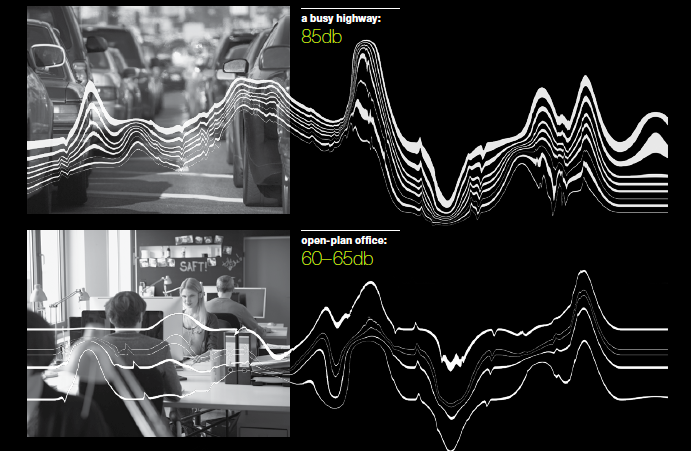
Farewell...
Workspring has chosen not to renew its lease in downtown Chicago. It has been our team’s pleasure to provide thousands of training, brainstorming and strategizing experiences to companies across the globe, and we are grateful to all of our customers. If you need to contact us, email info@workspring.com.
What’s the Most Distracting Noise?

.
Noise
Defined by scientists as “unwanted sound”—noise puts a burden on our hearts and brains, as well as our ears, according to Dr. Wolfgang Babisch, a lead researcher in the field of environmental noise and a senior research officer at the German Federal Environmental Agency.
In offices, irritating noise can come from all kinds of sources: air conditioning, obnoxious ringtones, traffic, nearby construction, unsophisticated sound-masking systems and—especially—from other people’s voices, says Julian Treasure, chairman of a United Kingdom-based consultancy, The Sound Agency. Noisy environments tend to only get worse over time, because people start speaking louder as it gets noisier around them (known as the Lombard effect).
Annoyance is the most common response to noise, says Babisch, and that’s not as trivial as it may sound. We are easily set off by noise because we have been programmed as humans to be aware of sounds as possible dangers, going back to when our evolutionary predecessors had many enemies in the wild. This sensitivity to sounds has stayed in our neurobiology—we’re constantly alert to our environment, and noise easily makes us uneasy. Lab studies on humans as well as animals have shown that exposure to noise arouses the nervous system, causing rising blood pressure and the release of stress hormones. Over time, these instinctive responses can stress the cardiovascular system and give rise to negative outcomes such as anger and exhaustion.
“Cognitively, there is plenty of research now that shows that the most destructive sound of all is other people’s conversations,” agrees Treasure. “We have bandwidth for roughly 1.6 human conversations. So if you’re hearing somebody’s conversation, then that’s taking up 1 of your 1.6. Even if you don’t want to listen to it, you can’t stop it: You have no earlids. And that means you’ve just .6 left to listen to your own inner voice.”
The recommended noise level by the German Association of Engineers for intellectual work pertains to participating in discussions and meetings as well as working solo. While 70 decibels is acceptable for simple or mainly transactional office work, 55 decibels is the requirement for “mainly intellectual work.” In fact, the association recommends the same limit on noise for a doctor performing surgery as for office workers doing intellectual work, alone or together.
In other words, in noisy environments with poor acoustics, workers can as easily get stressed by trying to hear others as by trying not to hear others—a lose/lose proposition.
The solution, says Treasure, is a variety of workplace environments, each designed with consciousness of sound for the task and the people using the spaces. Work environments need to be designed not just for appearance, but also for experience in all the senses, especially hearing. “Consciousness of sound is a new tool to design with,” says Treasure. “Good acoustics can make environments more productive.”
.
Read the full research on The Privacy Crisis by Steelcase here.